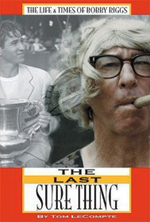The Life of Bobby Riggs
Tom LeCompte

Asked once what he'd like his epitaph to be, Bobby Riggs joked: "He Put Women on the Map." Doubtless, he will forever be remembered as the motor-mouthed antagonist to Billie Jean King in their "Battle of the Sexes" challenge in 1973, a match that became a watershed event in women's sports and made tennis history as the most-watched match ever, with more than 30,000 inside the Houston Astrodome and another 90 million worldwide watching on television.
But Bobby Riggs was more than that. Showman, hustler, huckster, Bobby Riggs was one of the great characters in modern sports-a hardscrabble kid in a highbrow, "sissy" game; the son of a fundamentalist minister; a compulsive gambler; a self-proclaimed male chauvinist whose only mentors in the game were women; a short, wispy-haired fellow with a squeaky voice, a bad haircut, and horned-rimmed glasses who became, somehow, a sex symbol.
Master of Preposterous
Stories about Bobby are legion--stories that manage to grow a bit more preposterous with each retelling. How he won his first racquet in a game of marbles. How on his first and only trip to Wimbledon in 1939, he won a small fortune on a longshot bet that he'd win the men's singles, men's doubles, and mixed doubles titles. Or how, as an over-the-hill, 55-year-old player, he hustled games by playing around an obstacle course of chairs scattered on his side of the court. Or while wearing an overcoat and snowshoes. Or leashed to a lion cub.

Bobby's contests were not limited to tennis. In 1984, he challenged professional golfer Marilynn Smith to a game in which he was allowed to throw the ball at the green 18 times during the match. He won.
In 1975, Bobby ran a 50-mile race across Death Valley against long-distance runner Bill Emmerton, a race in which Emmerton gave Bobby a 25-mile head start. Riggs won.
In 1974, Bobby bet daredevil Evel Knievel $25,000 that he could ride a motorcycle 650 miles in 72 hours from Las Vegas to Twin Falls, Idaho, where Knievel was to attempt his ill-fated jump across the Snake River Canyon.
Bobby had never ridden a motorcycle and claimed he didn’t know how to use the brakes, but arrived just in time to see Knievel's rocket-powered motorcycle sink beneath the canyon rim, and said, "Oh, my god! Evel is gone and my $25,000 with him!"
Miraculously Evel survived and eventually paid Riggs, who donated the money to charity.
The stories themselves became commodities. For a price, you could have your own Bobby Riggs story. At a hundred dollars a shot, Bobby would take on all comers in these goofy handicap matches. After taking their money, he would hand back an "I Was Hustled by Bobby Riggs" button.

To some it was a badge of honor, like being able to claim you had struck out against Roger Clemens. But if you didn't have the time, energy, or inclination to actually play tennis, you could send Bobby the $100 and he'd just send you back the button. By the time of his match against Billie Jean King, the stories had become the man.
"If I can't play for big money, I play for a little money. And if I can't play for a little money, I stay in bed that day," Bobby told 60 Minutes’ Mike Wallace in 1973.
Actual Tennis
Bobby was the "Bad Boy of Tennis" long before players such as John McEnroe and Jimmy Connors inherited the mantle—a nickname slapped on him by the press in the Thirties because of his brashness, his penchant for dice and cards, and his feuds with the tennis establishment.
The game was a sport for amateurs then, and those who ran it expected the players to be modest and wholesome. There was no prize money. A system of under-the table payments evolved that allowed the players to make ends meet, while perpetuating the power of the amateur authorities.

Bobby, however, was too brash and too blatant about taking the covert payments. At one point, he was nearly banned from the game-not for his gambling, which today would have gotten him ousted from sports faster than you can say, "Pete Rose," but for "professionalism."
But after a stint in the Navy during World War II, Bobby actually turned professional. Along with Jack Kramer, Pancho Segura, Pancho Gonzalez, and a handful of other players, he barnstormed across the nation playing tennis in a series of one-night stands in auditoriums, hockey rinks, high-school gymnasiums, any place they could fit their portable canvas court.
Click Here to see a news real of Bobby defeating the great Kramer in 4 sets at Madison Square Garden in 1947. The success of these tours in the Forties and Fifties laid the foundation for the rest of the game to turn professional in 1968.
Bobby officially retired from tennis in 1952. He married a rich girl and got a regular job. His days as a top player behind him, he should have faded into obscurity. He likely would have had it not been for his intense competitive drive, his knack for showmanship and self-promotion, and a little luck. Following the end of his turbulent 20-year marriage, his "comeback" in the early 1970s launched a whole new tennis career for him-one short on athleticism, but long on bravado.

As sport, the Bobby Riggs-Billie Jean King match meant absolutely nothing. This was about spectacle, not tennis. Nevertheless, for the fledgling women's tennis tour and the larger women's movement, it was a watershed event.
It was both a social and political statement, a declaration of presence. And for a nation weary of the Vietnam War and the ordeal of Watergate being played out each day on television, it provided a much-needed distraction.
Afterwards, Bobby discovered he could make a good living just being himself: playing tennis exhibitions, doing his wacky challenges, traveling the country, hustling at whatever and with whomever came his way. So what if most people considered him a wise-guy, an aging buffoon? He was having the time of his life, and attracting more attention than he ever had when he was at the top of his game.
Had it not been for that one spectacular loss to King, he might also have been remembered as a gifted athlete, a sportsman, and a genuine champion. Though scrappy and brash, he succeeded in both the amateur and pro ranks.
Bobby died Oct. 25, 1995, from prostate cancer. He was 77. Though no one would call him a beloved sports figure, he was in his way lovable--a genial rogue, a perpetual adolescent who was able to both aggravate and endear. He was a character, a man addicted to competition and the challenge of a contest-any contest. It was this love, this addiction that propelled him to the top of the tennis world and later made him an international celebrity and a social icon.
Writing his own best epitaph, Bobby once said, "The best thing in life is to win. The second best thing in life is to lose ... at least you're in the game." Bobby usually won, but he was always in the game.





